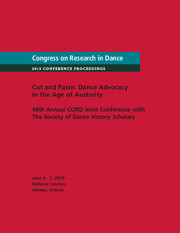Article contents
(Re)Searching in the (You)Tube: Digital Archives and Dance Practices
Published online by Cambridge University Press: 02 August 2016
Abstract
It is a commonly held assumption that new technologies have changed human society, culture, and communication dramatically. New phenomena appear, and the new reality is a challenge on many levels. The mass expansion of the Internet, since the early 1990s, has brought new circumstances at the economic, social, and cultural levels, as well as new forms of behavior and expression. In recent years, the basic practice of instructors, dancers, and dance enthusiasts is searching and downloading videos on traditional Greek dancing. In many cases, the videos are considered “research” products capable of supporting the teaching of dance in traditional dance groups. What inevitably emerges is a mode of YouTube as a new digital dance archive. In this peculiar condition, the production, distribution, and “assessment” of the content are in the hands of the user community, who, as Derrida notes, are possessed by one “irrepressible desire to return to the origin”. In Foucault's terms, the archive is a space of enunciation. Repositioned as something that defies exhaustive description, for Foucault, the archive becomes engaged in the production and authorization of discourse itself. This perspective raises questions about the issues of standards, evaluation, and quality of the “material”. But, the most important question is, what is the concept and the content of the terms “research” and “teaching?”
- Type
- Research Article
- Information
- Copyright
- Copyright © Christos Papakostas 2016
References
Works Cited
- 1
- Cited by


